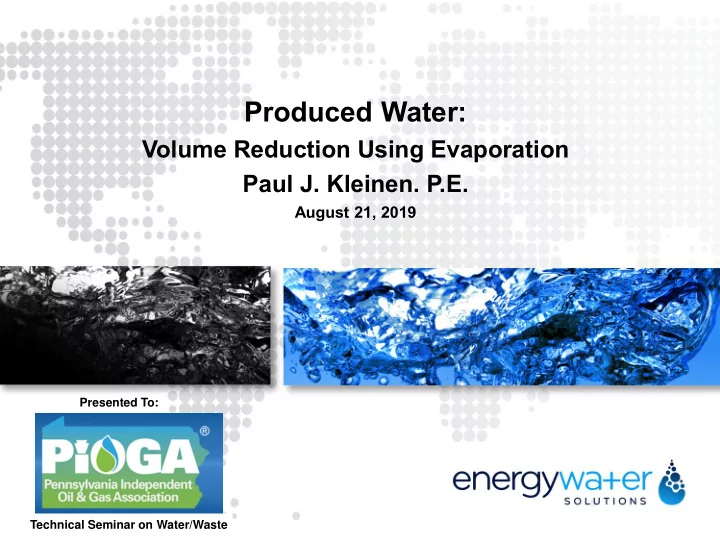

Produced Water: Volume Reduction Using Evaporation Paul J. Kleinen. P.E. August 21, 2019 Presented To: June 2019 Technical Seminar on Water/Waste
Agenda Energy Water Solutions The Technology The Equipment Applications Review Permitting Process What does Evaporation Technology offer? 2
Energy Water Solutions (EWS): Company Overview Who We Are How We Create Value Private Energy Services company EWS is a reliable partner that will: focused on water management Save customers money We base our business model on four Operate safely and reliably pillars Be an integral part of customer’s – Bringing economic value to our water management program customers Be good stewards of the – An outstanding safety culture environment – Being reliable in everything we do – Maintaining a culture of Our Safety & Service Focus sustainability What We Do Capable, knowledgeable, experienced energy sector team Produced/Flow-back Water Evaporation – Full compliance with customer HSE Reduce wastewater volumes 20%-80% standards and practices through mechanical evaporation. – 8+ years of oilfield work completed Our Vaporization in a Box (VOX evaporator unit) meets or exceeds PADEP’s safely – Zero fatalities, lost time incidents or requirements for a streamlined permitting reportable incidents process Provide an economical solution based on ideal customer’s needs 3
What to look for in the Technology? The equipment ▪ Low Emissions ▪ Reliable ▪ Efficient ▪ Cost Effective ▪ Small footprint Market Focus: ▪ Produced water from oil and gas exploration and production ▪ Water from gas midstreamers (pipelines, compression) ▪ Other Applications: industrial wastewater such as cooling process blowdown or process waste (e.g., mining or power generation) 4
The Equipment ✓ Nominal (40-80) evaporation capacity is terms of bbl/day ✓ Gas: under 2.5 Mbtu/hr ✓ Electric Power: under 6 Kw ✓ Self powered for use in locations where line power is not available ✓ Stack test to meet particulate emissions less than 1.0 tpy ✓ Minimal staff needed ✓ Remote operating 5
6 Example of Pad Integration: Generic Flow Diagram Produced Water Tank Farm Brine Tank Gas Water Truck Dehydrator Evaporator Equipment Well Heads 6
Mobilization: What should the provider handle? It is optimal where the provider of the equipment takes complete responsibility for the successful, safe, and reliable operation of their unit, by doing the following: Handle the air permitting process (if any) in cooperation with producer’s permit and environmental staff A performance and quality check prior to the unit being shipped, including: – A 24-hour factory acceptance test, verifying evaporation rates, gas requirements, control sequences and start up/shutdown Plan, manage and execute all aspects of transportation, installation, commissioning and start-up Provide secondary containment for all units on customer’s pad Provide complete on-site operational support and maintenance for the unit 7
Mobilization: What Does the Customer Handle? Site or customer specific HSE instructions/guidance/permits – Customer permits (OG 71/71a, WMGR 123) – Policies and procedures for safe and responsible operations – Equipment siting criteria (e.g., spacing from existing operations) – Operations and HSE emergency contacts – Police, fire and EMS contacts Site modifications to support evaporation which typically include: – Produced water and brine connection lines – Gas service to the unit – Access to pad – Produced water and brine storage Removal of concentrated brine – Pipeline – Truck 8
Permitting Process If the equipment meets the annual particulate emissions (PM) under the 3 ton/year threshold, and a burner consuming less than 2.5 Mbtu/hr a unit should be able to be put in service quickly On Pad Processing ▪ Construction: RFD issued by Air Quality Department Regional Office based on GP-5A Category 38 exemption and completion of the standard RFD application with required supporting exhibits ▪ OG 71: Request for Approval of Alternative Waste Management Practices: captive processing of wastewater Operations are subject to permit conditions including ongoing monitoring and record keeping as established by DEP Off Pad Processing ▪ Waste Permit: Individual Processing Permit (facility) ▪ Construction: RFD, (ideally unit should be exempt from Plan Approval) 9
What does Evaporation Technology offer? Evaporation Technology Offers Customers: ▪ Immediate reduction in wastewater transportation and disposal costs ▪ Zero customer CAPEX based on pay for performance model ▪ Streamlined permitting based if meet exemption emissions ▪ Small footprint minimizes on-pad operations impact ▪ Modular design allows scaling to meet demand, rapid mobilization and easy redeployment ▪ Positive net benefits in environmental (emissions), safety, and community relations (reduced truck traffic) 10
Energy Water Solutions 11233 Crown Park Drive Houston, TX www.energywatersolutions.com Paul Kleinen Gregg Johnson President CEO Paul.Kleinen@energywatersolutions.com Gregg.Johnson@energywatersolutions.com
Recommend
More recommend